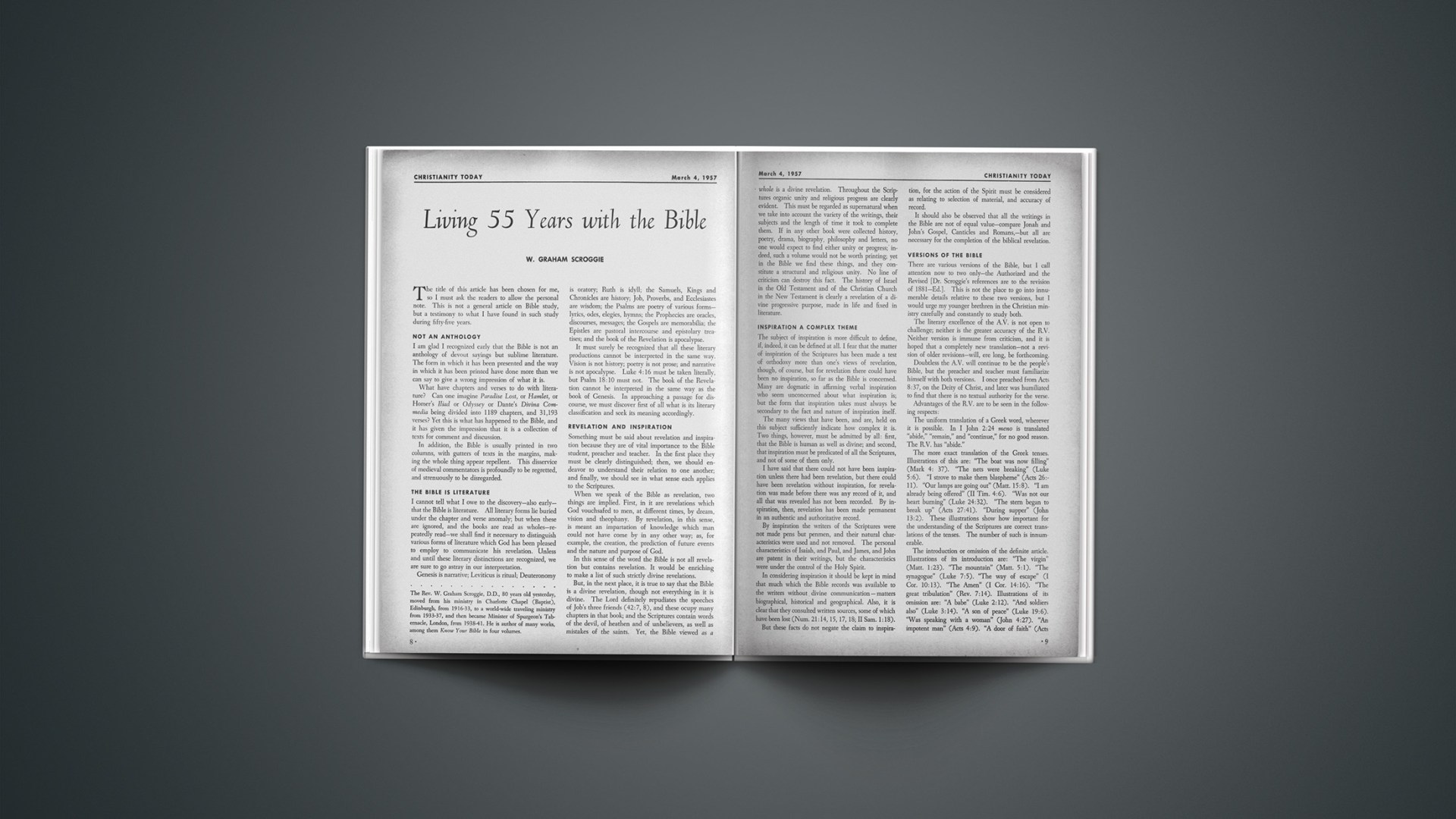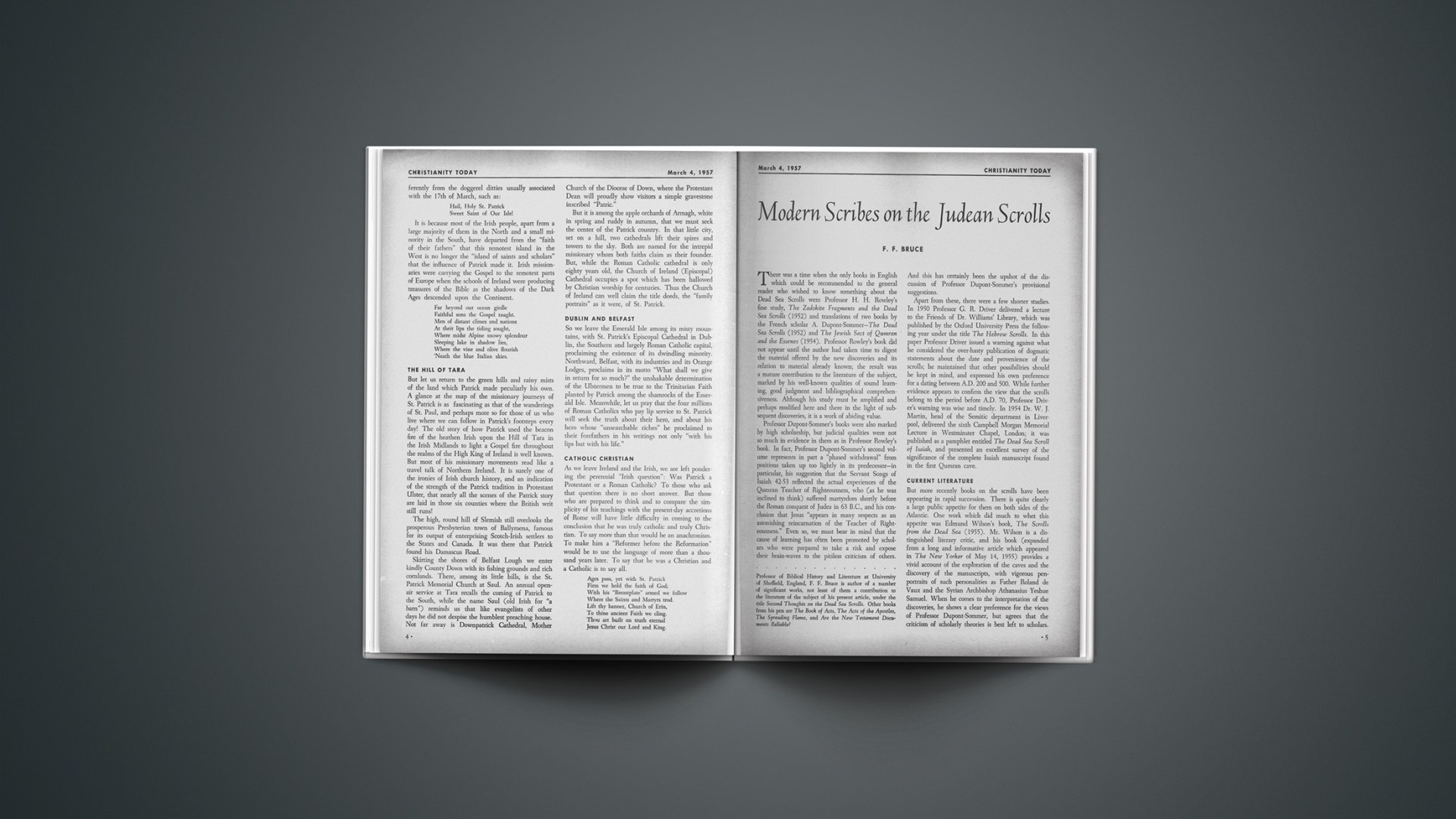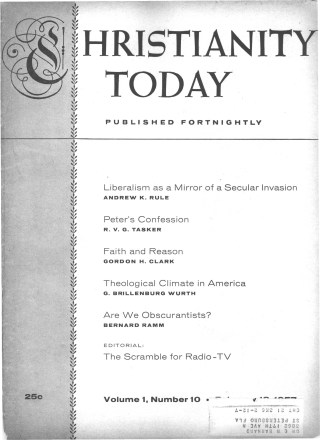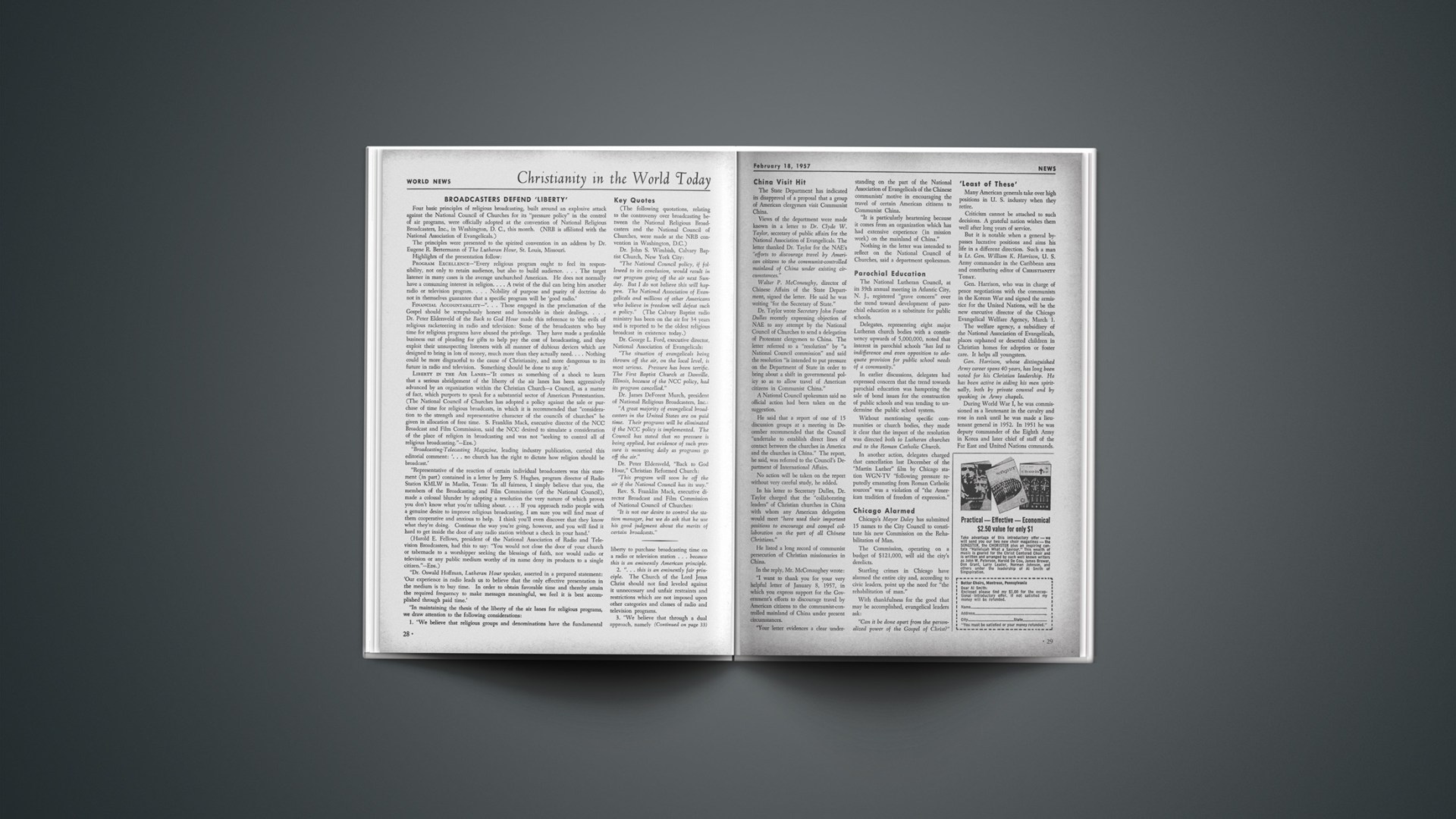The title of this article has been chosen for me, so I must ask the readers to allow the personal note. This is not a general article on Bible study, but a testimony to what I have found in such study during fifty-five years.
Not An Anthology
I am glad I recognized early that the Bible is not an anthology of devout sayings but sublime literature. The form in which it has been presented and the way in which it has been printed have done more than we can say to give a wrong impression of what it is.
What have chapters and verses to do with literature? Can one imagine Paradise Lost, or Hamlet, or Homer’s Iliad or Odyssey or Dante’s Divina Commedia being divided into 1189 chapters, and 31,193 verses? Yet this is what has happened to the Bible, and it has given the impression that it is a collection of texts for comment and discussion.
In addition, the Bible is usually printed in two columns, with gutters of texts in the margins, making the whole thing appear repellent. This disservice of medieval commentators is profoundly to be regretted, and strenuously to be disregarded.
The Bible Is Literature
I cannot tell what I owe to the discovery—also early—that the Bible is literature. All literary forms lie buried under the chapter and verse anomaly; but when these are ignored, and the books are read as wholes—repeatedly read—we shall find it necessary to distinguish various forms of literature which God has been pleased to employ to communicate his revelation. Unless and until these literary distinctions are recognized, we are sure to go astray in our interpretation.
Genesis is narrative; Leviticus is ritual; Deuteronomy is oratory; Ruth is idyll; the Samuels, Kings and Chronicles are history; Job, Proverbs, and Ecclesiastes are wisdom; the Psalms are poetry of various forms—lyrics, odes, elegies, hymns; the Prophecies are oracles, discourses, messages; the Gospels are memorabilia; the Epistles are pastoral intercourse and epistolary treatises; and the book of the Revelation is apocalypse.
It must surely be recognized that all these literary productions cannot be interpreted in the same way. Vision is not history; poetry is not prose; and narrative is not apocalypse. Luke 4:16 must be taken literally, but Psalm 18:10 must not. The book of the Revelation cannot be interpreted in the same way as the book of Genesis. In approaching a passage for discourse, we must discover first of all what is its literary classification and seek its meaning accordingly.
Revelation And Inspiration
Something must be said about revelation and inspiration because they are of vital importance to the Bible student, preacher and teacher. In the first place they must be clearly distinguished; then, we should endeavor to understand their relation to one another; and finally, we should see in what sense each applies to the Scriptures.
When we speak of the Bible as revelation, two things are implied. First, in it are revelations which God vouchsafed to men, at different times, by dream, vision and theophany. By revelation, in this sense, is meant an impartation of knowledge which man could not have come by in any other way; as, for example, the creation, the prediction of future events and the nature and purpose of God.
In this sense of the word the Bible is not all revelation but contains revelation. It would be enriching to make a list of such strictly divine revelations.
But, in the next place, it is true to say that the Bible is a divine revelation, though not everything in it is divine. The Lord definitely repudiates the speeches of Job’s three friends (42:7, 8), and these ocupy many chapters in that book; and the Scriptures contain words of the devil, of heathen and of unbelievers, as well as mistakes of the saints. Yet, the Bible viewed as a whole is a divine revelation. Throughout the Scriptures organic unity and religious progress are clearly evident. This must be regarded as supernatural when we take into account the variety of the writings, their subjects and the length of time it took to complete them. If in any other book were collected history, poetry, drama, biography, philosophy and letters, no one would expect to find either unity or progress; indeed, such a volume would not be worth printing; yet in the Bible we find these things, and they constitute a structural and religious unity. No line of criticism can destroy this fact. The history of Israel in the Old Testament and of the Christian Church in the New Testament is clearly a revelation of a divine progressive purpose, made in life and fixed in literature.
Inspiration A Complex Theme
The subject of inspiration is more difficult to define, if, indeed, it can be defined at all. I fear that the matter of inspiration of the Scriptures has been made a test of orthodoxy more than one’s views of revelation, though, of course, but for revelation there could have been no inspiration, so far as the Bible is concerned. Many are dogmatic in affirming verbal inspiration who seem unconcerned about what inspiration is; but the form that inspiration takes must always be secondary to the fact and nature of inspiration itself.
The many views that have been, and are, held on this subject sufficiently indicate how complex it is. Two things, however, must be admitted by all: first, that the Bible is human as well as divine; and second, that inspiration must be predicated of all the Scriptures, and not of some of them only.
I have said that there could not have been inspiration unless there had been revelation, but there could have been revelation without inspiration, for revelation was made before there was any record of it, and all that was revealed has not been recorded. By inspiration, then, revelation has been made permanent in an authentic and authoritative record.
By inspiration the writers of the Scriptures were not made pens but penmen, and their natural characteristics were used and not removed. The personal characteristics of Isaiah, and Paul, and James, and John are patent in their writings, but the characteristics were under the control of the Holy Spirit.
In considering inspiration it should be kept in mind that much which the Bible records was available to the writers without divine communication—matters biographical, historical and geographical. Also, it is clear that they consulted written sources, some of which have been lost (Num. 21:14, 15, 17, 18; 2 Sam. 1:18).
But these facts do not negate the claim to inspiration, for the action of the Spirit must be considered as relating to selection of material, and accuracy of record.
It should also be observed that all the writings in the Bible are not of equal value—compare Jonah and John’s Gospel, Canticles and Romans,—but all are necessary for the completion of the biblical revelation.
Versions Of The Bible
There are various versions of the Bible, but I call attention now to two only—the Authorized and the Revised [Dr. Scroggie’s references are to the revision of 1881—Ed.]. This is not the place to go into innumerable details relative to these two versions, but I would urge my younger brethren in the Christian ministry carefully and constantly to study both.
The literary excellence of the A.V. is not open to challenge; neither is the greater accuracy of the R.V. Neither version is immune from criticism, and it is hoped that a completely new translation—not a revision of older revisions—will, ere long, be forthcoming.
Doubtless the A.V. will continue to be the people’s Bible, but the preacher and teacher must familiarize himself with both versions. I once preached from Acts 8:37, on the Deity of Christ, and later was humiliated to find that there is no textual authority for the verse.
Advantages of the R.V. are to be seen in the following respects:
The uniform translation of a Greek word, wherever it is possible. In 1 John 2:24meno is translated “abide,” “remain,” and “continue,” for no good reason. The R.V. has “abide.”
The more exact translation of the Greek tenses. Illustrations of this are: “The boat was now filling” (Mark 4:37). “The nets were breaking” (Luke 5:6). “I strove to make them blaspheme” (Acts 26:11). “Our lamps are going out” (Matt. 15:8). “I am already being offered” (2 Tim. 4:6). “Was not our heart burning” (Luke 24:32). “The stem began to break up” (Acts 27:41). “During supper” (John 13:2). These illustrations show how important for the understanding of the Scriptures are correct translations of the tenses. The number of such is innumerable.
The introduction or omission of the definite article. Illustrations of its introduction are: “The virgin” (Matt. 1:23). “The mountain” (Matt. 5:1). “The synagogue” (Luke 7:5). “The way of escape” (1 Cor. 10:13). “The Amen” (1 Cor. 14:16). “The great tribulation” (Rev. 7:14). Illustrations of its omission are: “A babe” (Luke 2:12). “And soldiers also” (Luke 3:14). “A son of peace” (Luke 19:6). “Was speaking with a woman” (John 4:27). “An impotent man” (Acts 4:9). “A door of faith” (Acts 14:27). “To an unknown god” (Acts 17:23). “A root” (1 Tim. 6:10). These and other instances “throw emphasis on the character of the subject instead of the concrete subject itself” (Westcott).
The improvement of archaic words. “Weapons” for “artillery” (1 Sam. 20:40). “The flax was in bloom” (Exod. 9:31). “Brigandines” is translated “coats of mail” (Jer. 46:4). “Goods” for “carriage” (Judg. 18:21). In Philippians 3:20 “conversation” is “citizenship”; and in 1 Peter 3:1 it is “manner of life.” “Daysman” is “umpire” in Job 9:33. Other illustrations will be found in 1 Samuel 5:6, Acts 28:13, Matthew 20:11, Psalm 4:2, 1 Thessalonians 4:15. It must be clear to any reader that these changes are illuminating.
To mark the use of the prepositions in the New Testament is of vital importance. The significance of these is often lost in the A.V. In Matthew 28:19 baptism is to be “into (eis), not “in” (en) the name. In Romans 6:23 “the free gift of God is eternal life ‘in,’ not ‘through,’ Christ Jesus our Lord” (en, not dia). In Acts 13:39 “in him” should be read instead of “by him” (en, not dia). Also in 1 Peter 5:10 and in 1 Corinthians 1:4 it is “in,” not “by” Christ Jesus. The prepositions in 1 Corinthians 12:8, 9 should be marked. The word of wisdom is given “through” (dia) the Spirit. The word of knowledge is given “according to” (kata) the same spirit; and faith is given “in” (en) the same Spirit. In 1 John 3:3 the R.V. makes clear what the A.V. confuses. According to the latter, the hope is “in” the individual, but in the R.V. we read, “every one that hath this hope ‘set on’ (epi) him (Christ).”
These are but a few illustrations of the importance of the R.V. in respect of greater accuracy than the A.V.; but the R.V. is not always correct, and is sometimes pedantic.
Use Of Translations
Translations, of which there are many, are not the same as versions. There are translations in Great Britain by Alford, Conybeare and Howson, Darby, The Twentieth Century New Testament, Weymouth, Moffatt, Knox, Williams, Phillips; and in America, a translation of the whole Bible by Smith and Goodspeed, and the Revised Standard Version of 1946, which is a revision of the American Standard Version of 1901.
The problem in any translation is twofold: to be faithful to the original sources, and yet to present those sources in the idiom of the language of the translation.
I have found it interesting and profitable to read all available translations, though I have never regarded it as wise to use the modern translations in reading the pulpit lessons.
Interpretation And Application
Another matter on which I have strong convictions relates to interpretation and application. All Scripture—or most of it—can be applied to our diversified circumstances and needs, but such application is rarely interpretation.
“Every Scripture is inspired of God and is profitable for teaching, for reproof, for correction, for instruction which is in righteousness; that the man of God may be complete, furnished completely unto every good work” (2 Tim. 3:16,17). That great passage warrants and defines the present application of the Scriptures to us all.
But application must be safeguarded, or we shall be applying what does not apply. During the Great War many Christians claimed the promises of Psalm 91:3–8, but they were not protected from the German bombs. The kinds of blessings vouchsafed to the Christian are not material and physical, as they were to Israel. On the other hand, such a passage as Judges 14:14 is eminently applicable, because blessings often come out of the things that are against us. If we destroy the destroyer we find deliverance.
But the interpretation of Scripture is a very different and exacting pursuit. Not a little preaching is much more imposition than exposition. An expositor must be a student, and must be subject to the rules which govern interpretation. If these rules are disregarded, and all such matters as time, place, form, and circumstances are neglected, one can prove anything from the Scriptures.
Unless we have regard for the context of a passage, we are almost bound to fall into error. Innumerable sermons have been preached on Christ’s redeeming passion from Isaiah 63:3: “I have trodden the winepress alone”; but the plain fact is that it has nothing whatever to do with Christ’s death, as the rest of the verse shows (cf. Rev. 14:19,20). There are plenty of texts in the Bible on the Cross without taking a sentence entirely out of its context and applying it to that. Another passage which is often wrongly interpreted is Colossians 2:21: “Touch not; taste not; handle not.” Temperance enthusiasts have claimed that here the use of alcohol is forbidden. But not only has the passage no reference whatever to temperance, but “touch not; taste not; handle not” is condemned: “why, as though living in the world are ye subject to (such) ordinances? (as) …” If context has nothing to do with exposition the preacher might as well descant on the obiter dicta of Shakespeare, Milton, Dante or anyone else.
Another principle of interpretation is in the fact that all that Scripture has to say on any given subject is the truth about that subject. Proof texts often prove nothing. Scripture must be compared with Scripture (cf. 1 Cor. 2:13). On the subject of faith and works, Paul and James are not at variance, for they are looking at the same subject from opposite standpoints. Paul says that Abraham was justified by faith (Rom. 4:9); James says that he was justified by works (ch. 2:21), but the one is referring to the root, and the other to the fruit of his relation to God. Faith makes works possible, and works make faith evident.
True interpretation must regard the Scriptures grammatically. We have already illustrated this in what has been said about the tenses, articles, pronouns, and prepositions in the R.V.
There must be careful study of the meaning of words. Sin is described by many words, each having its own significance—iniquity, trespass, guilt, transgression, lawlessness, and so forth. We should study the difference between the Grave, Hades, Gehenna, and Topheth. There are five words for servant; two for love; three for know; two for life; two for new; two for another; six for preach; three for wash; four for master; four for child; and two for basket. These illustrations will indicate how important it is, for the understanding of the Bible, to study its words.
Much of the language of Scripture is figurative, and this is most important for interpretation. We must recognize the vast difference between such statements as: “In the morning, a great while before day, Jesus rose up and departed into a desert place, and there prayed,” and “Judah is a lion’s whelp,” or “I am the vine.” We must be careful and conscientious in our study of allegories, types, parables, metaphors, fables and symbols. These can easily be wrongly understood and fancy can easily make havoc of truth. Not every illustration is a type, but typical teaching is warranted by Scripture (1 Cor. 10:1–11; John 1:14, R.V., 3:14). Parables are not the source of doctrine, but they may illustrate it. Generally speaking, each parable has one great lesson to convey, and all its details should not be pressed as interpretation.
Great care should be taken in the study of prophecy. We must distinguish between forthtelling and foretelling. All prophecy is not predictive. The prophet spoke first of all to his own generation, but in doing so he often spoke beyond his knowledge and to generations to come (cf. 1 Peter 1:10–12). The prophets were preachers, but they were also seers. Not a few predictions have already been fulfilled, and many remain to be fulfilled. In the study of prophecy, sanity is essential.
The theological student who, on leaving college, puts his Hebrew and Greek on the shelf is crippling his usefulness as an expositor, because no version or translation of the Scriptures makes a knowledge of the original language unnecessary. It is of great advantage to be able to compare the Hebrew of the Old Testament with the Septuagint, and to discern the use of each of them in the New Testament. The bearing of this upon interpretation must be obvious.
Although, I fear, my reflections are already too long, I must refer to one more thing, perhaps the most formative in my more than fifty years of study. What I refer to is the discovery that the books make a Book; that all the writings are part of one revelation. This is a proof of divine inspiration second to none.
The sixty-six books of the Bible span 1500 years in the writing. They came from many authors, who wrote in different places, on various subjects, and in many styles; yet, when gathered together finally in the fourth century A.D. they are seen to constitute a sublime whole, an unfolding drama of redemption. This drama has a prologue, Genesis 1:1–11:9; an interlude, between the two Testaments; and an epilogue, the book of the Revelation.
Between the prologue and the interlude is Act 1, Genesis 11:10—Malachi 4; and between the interlude and the epilogue is Act II, Matthew to Jude. Act I is a divine Covenant of Law embodied in the history and literature of a Semitic race; and Act II is a divine Covenant of Grace embodied in the history and literature of the Christian Church.
In Act I are three scenes: the Hebrew family, the Israelitish nation and the Jewish Church.
In Act II are two scenes: the introduction of Christianity into the world by Jesus the Messiah, and the progress of Christianity in the world to the close of the first century A.D. If you arrange these details in chart form you will see how marvellous is this biblical synthesis. This has been the basis of all my Bible work for forty-five years at least.
In the ways here indicated I have lived with the Bible for fifty-five years, and in my eightieth year I am gathering together in three volumes the final results. If what I have said puts some of my brethren in the way of fruitful Bible study I shall be grateful.
Professor of Biblical History and Literature at University of Sheffield, England, F. F. Bruce is author of a number of significant works, not least of them a contribution to the literature of the subject of his present article, under the title Second Thoughts on the Dead Sea Scrolls. Other books from his pen are The Book of Acts, The Acts of the Apostles, The Spreading Flame, and Are the New Testament Documents Reliable?












